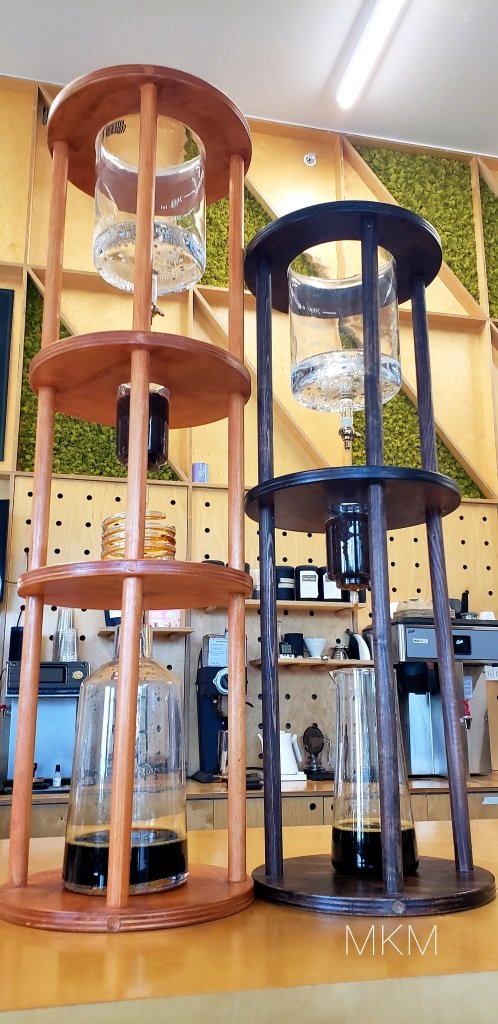By Michael Kinney
OKLAHOMA CITY- Every time I have walked into Culture Coffee (1029 NE 6th), one of the first things to catch my eye is what appears to be a science project sitting on the front counter. Sitting four feet high and encased in a bamboo tower with tubes and glass bottles, the contraption captured my attention.
Yet, I would never ask about it. I would just stare out and then order my black coffee with sweetener and almond milk. Now and then, if it was blazing outside, I’d get a citrus-based tea.
But that machine would sit on the counter, not being used and mocking my curiosity.
That all changed when I strolled into Culture Coffee blistering hot afternoon and saw the baristas’ were actually using it. What appeared to be water was dripping from a large glass jar at the top of the structure into a smaller beaker filled with what I assumed was coffee grounds. From there it slowly dripped into a curvaceous tube and into another glass jar at the bottom of the counter.
This was how I finally learned about Cold Brew Coffee. It was a term I had seen but never used. I had just assumed they meant coffee that had been brewed and then put into the fridge for a bit. I was wrong.
But according to all the people who looked at me and laughed when I told them about this new drink, it has been around for a while. Regardless, my curiosity finally won out and I started asking questions.
Cold brew coffee is a method of brewing coffee that involves steeping coarsely ground coffee beans in cold or room temperature water for anywhere from 12 to 24 hours. According to the barista, this process allows for a slow extraction of the coffee’s flavors, resulting in a smoother, less acidic beverage compared to traditional hot brewing methods.
Even though I grew up on Folgers coffee and bad convenience store joe in that could be hours old, in the two years I worked at a Barnes & Noble/Starbucks outside Seattle, I’ve had a taste for good coffee products. So I had to find out more about this process.
To prepare cold brew coffee, the preparer must figure out the ratio of coffee grounds to water that is needed. That is already too much math for me, but typically they use around one part coffee to four parts water.
The coffee grounds are mixed with the water in a jar or a cold brew system and left to steep for several hours. The long steeping time allows for the water to slowly extract the coffee’s oils, sugars, and caffeine, resulting in a concentrated coffee concentrate.
While there appears to be different kinds of steeping machines that can be used, the one I saw at Culture Coffee is called the Yama Glass Cold Brew Coffee Maker Tower. It costs just under $500, which can be a big investment for a small business to make.

Once the steeping process is complete, the coffee is typically filtered to separate the liquid from the grounds. This can be done using a mesh sieve, cheesecloth, or a specialized cold brew coffee filter. The result is a strong coffee concentrate that can be stored in the refrigerator for several days.
According to the shop’s barista, whom I call a coffee Jedi, from start to finish, the entire process takes four days before the cold brew will be served. That includes starting the process each morning when they arrive to work.
The first time I tasted it, I tried it straight. No cream or sugar. To call it strong would be an understatement. It felt like my body had been attacked. That was when I was told most people dilute it with water, milk or ice.
So once I added my customary sweetener, milk and honey, it was actually pretty good. It was still strong but had a smooth and mellow flavor at the same time.
In coffee shops or cafes, the average price for a cold brew coffee typically falls between $3 and $5 for a standard-sized cup. It is $3.50 at Culture Coffee. Another one of my favorite establishments, Toast & Coffee, serves Nitro Cold Brew for $4.
However, prices can vary significantly depending on the city and the establishment. In some upscale or specialty coffee shops, the price can range from $4 to $6 or more. If the shop claims to use high-quality specialty coffee beans, prepare to shell out big bucks.
While this would not be an everyday drink for me, I could definitely see myself sipping on one on a hot summer day. But that is almost every day in Oklahoma.
IG: mkinneymedia
Twitter: MKinneyMedia
Youtube: Michael Kinney Media
Photos: Michael Kinney
Threads: MKinneyMedia
